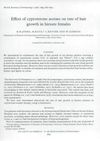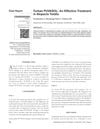Androgenic Alopecia: Characteristics and Perspectives
January 1992
in “
Juntendo Medical Journal
”

TLDR Male pattern baldness is mainly caused by a hormone called dihydrotestosterone (DHT), and drugs that can block this hormone might help prevent hair loss.
The document from 1991 discusses androgenic alopecia, also known as male pattern baldness, which accounts for over 95% of baldness in men. It is not considered a disease but a physiological phenomenon that usually begins in adolescence. The role of male hormones in this condition was established by Hamilton 50 years prior, who demonstrated that castrated individuals do not develop this type of baldness and that testosterone administration can resume hair loss in genetically predisposed individuals post-castration. In the late 1960s, Bruchovsky and Wilson discovered that not testosterone (T), but dihydrotestosterone (DHT) is the true male hormone in the prostate. The authors confirmed the importance of DHT in the hair follicle sebaceous gland and suggested that inhibitors of 5α-reductase (which converts T to DHT) and binding inhibitors of DHT could potentially prevent hair loss. Various anti-androgen drugs were clinically tested, but their effectiveness was often misunderstood due to the lack of distinction between hair growth and hair nourishment. The authors proposed a double-blind method involving hair diameter measurement and trichogram to demonstrate the preventive effect of these drugs. They also isolated several male hormone-dependent cDNA clones for further study, which could lead to new prevention possibilities.









